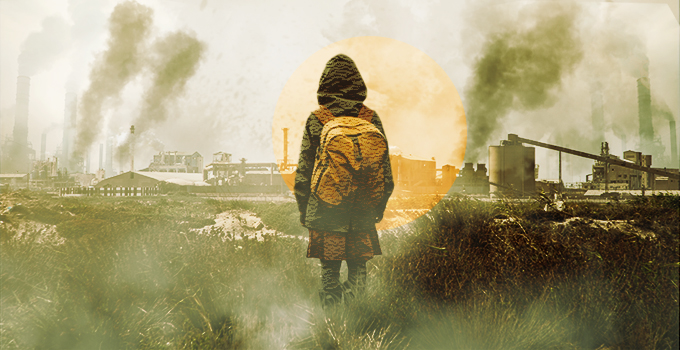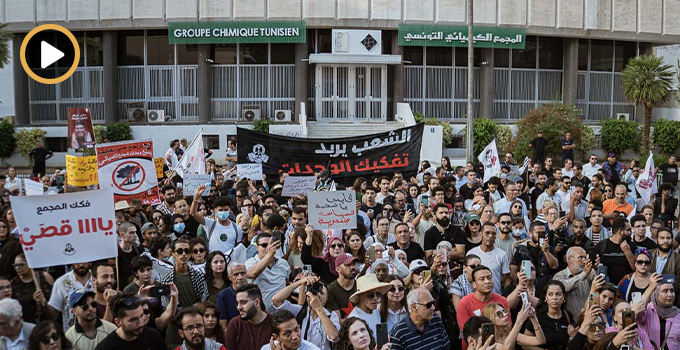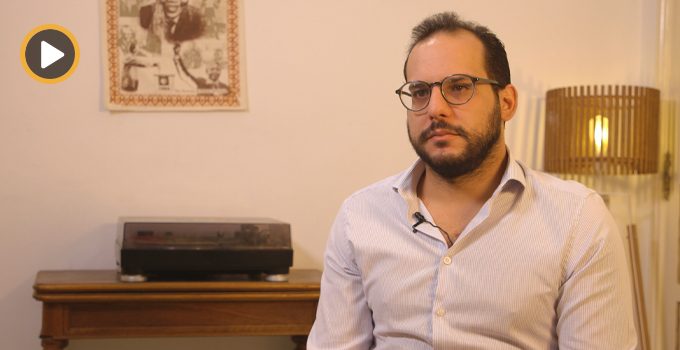Zabaltuna’s creator, 26-year old Oussama Houij, is not the first to use such images, a digital mashup or collage, to contest the current ecological dilemma. The world of Zabaltuna is peopled by figures from an ancient past, dignified-looking individuals in elaborate traditional clothing—jebba, sefsari, turbans, glimmering adornments, and holding swords, walking sticks and delicate china—set against insalubrious backgrounds: piles of garbage, overflowing dumpsters, landfill.

A self-made campaign
Houij graduated in June from the National Institute of Agronomy of Tunisia (INAT), where he studied agronomy, waste management and environmental protection. Passionate about themes relating to ecology, recycling, permaculture, and DIY culture, Houij asserts his decision to « distance » himself from a career as a sanitary engineer; the recent graduate is admittedly disillusioned by his academic experience. At each turn, he found himself disappointed by a packaged, outdated curriculum, by intolerance for creativity, by young peoples’ preference for office jobs and disinterest in getting their hands dirty. Having observed how government institutions in the domain operate and having visited waste and water treatment sites across the country, Houij laments the number of well-funded waste management projects, foreign funding and private-public partnerships for new treatment plants with no prospects for sustainability. In general, he says, projects are « operative for six months, then there is the first break-down, then six months of disrepair, six months of complaining, then the plant is forgotten and becomes an archeological site ». After years of this pattern, people have started to tell themselves that the waste issue is normal, says Houij. They don’t even see the problem anymore, or brush it aside as something the administration is responsible for. Unconvinced that a career in sanitary engineering would enable him to work on alternative waste management solutions, Houij turned to pursue projects that kept on the backburner as he finished his studies.
He launched Zabaltuna in August 2017, several months after the Ministry of Local Affairs and Environment had launched « Normal Hakka? », an awareness campaign against pollution in which celebrities pictured before garbage piles faced passersby with the question « Is this normal? ». For Houij, the effort was expensive, unoriginal and ineffective.

In contrast, Zabaltuna « literally costs nothing, and I can do it on my own ». More than this, the campaign is a creative outlet for Houij. « There was always this frustration because I couldn’t connect my studies with art ». He recalls turning in academic reports without the mandatory cover page; instead he would design his own title page, like a book cover featuring photographs he had taken in the field. « I would get minus 5 points for that », he notes with a laugh, adding that he would lose more points for not using the required font. « Why don’t you use the standard cover? Why don’t you use Times New Roman?! [professors would ask]. Because it’s ugly! There’s Helvetica and a bunch of other fonts in life », he would cry out in response. « I refused to follow the model, so I was knocked for that ».
Hacking the orientalist image
Houij has always taken pictures to document places visited and experiments conducted—such as the cultivation of cotton, roses, and geraniums irrigated with used water—and is self-taught in Photoshop. Many of the photos that Houij uses for Zabaltuna are from early morning expeditions through empty streets in downtown Tunis, public transit stations and especially the Medina.
I find myself in places that are literally… you can start crying it’s so beautiful, there’s so much history, there’s a lot of closed doors, you have to climb through a hole to discover something and you’re like woah, this is here? And no one knows about it…

« You’re tarnishing Tunisia’s image and tourism », some have commented in response to Houij’s campaign. First of all, begins Houij, tourists aren’t blind. « Tunisian society is extremely secretive about its problems…but we won’t ever resolve our problems if we continue to hide them ». The idea behind Zabaltuna is to draw attention directly to the issue. The orientalist characters that animate Houij’s pictures are drawings by European artists who travelled to the Maghreb in the 18th and 19th centuries to portray North Africans and their way of life. « I want to destroy this image », explains Houij, showing the contrast between this picturesque and idealized version of history with a bleak present-day reality.
While Zabaltuna began as an ecological reflection, subsequent themes relate to current events and social and political realities. In one photograph, a man sleeping in the street blends into the landscape; hovering over him, a guard from another era holds out an orange and smiles as if to taunt the reclining man. A young harem just out of the bath is dried off by an attendant while, in front of her, a police officer holds a baton overhead, poised to strike. A maidservant holding a tray of tea or coffee stands in the middle of an eco-friendly café that was recently closed by the environmental police in downtown Tunis.

« After 26 years in Tunisia, you learn a lot of things about life », muses Houij, « especially when you step out from the ‘normal way’ of doing things and observe how society reacts. You see someone dropping trash in the street, and his reality is that he’s doing nothing wrong…». He trails off, and after a moment picks up the thread of another thought.
I think there’s no way to live in Tunisia but to be a dreamer. If you’re not, you’re going to join the system, be a slave, at some point realize that you lost your life working under someone so that he gets richer, or you buy something you’re not happy with…losing all your time on things that don’t matter. It literally doesn’t matter to me to have a car, a house, new clothes. What matters is that you’re happy daily, even when you’re living in shit…
Houij is equal parts humor and passion. Whatever he does appears to be motivated by curiosity and a compulsion to explore history, landscapes and the « beauty hidden under a waste pile, hidden from the eyes of people, where nobody is willing to go ».





iThere are no comments
Add yours